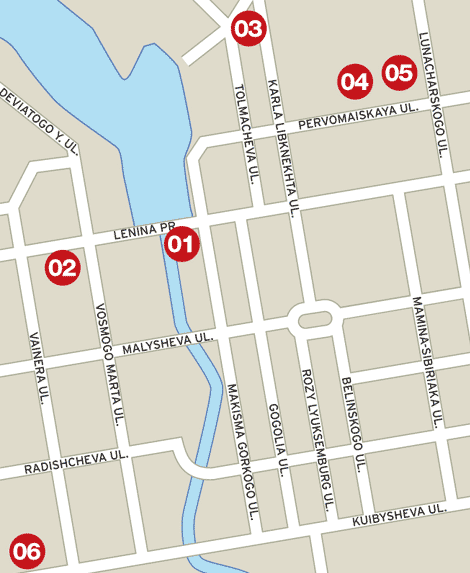As the capital of the Urals region, Ekaterinburg lies at the crossroads between Europe and Asia. Lee Karen Stow explores the city's striking monuments to Russia's eventful past

1. Plotinka, the Dam and Rhodonite
A good place to start is where Ekaterinburg was officially founded, in 1723, as the birthplace of Russian industry. Here stretches a 209-metre long dam, which has been reconstructed twice since being built 1723, and is now a recognised industrial monument. You can see the slits through which the water ran to work the wheels like a water mill. Few buildings of the old wooden factory area still survive, although you can see the oldest one, which dates from 1764 and is now home to the Fine Arts Museum. Relics of early industry dot the surrounding Historical Park, including lumps of Ural rock and a large sample of rhodonite (a typical Ural mineral). On the left bank of the Iset River rises a monument to the founders of Ekaterinburg on the site of their first iron mill.
2. Russian Market
Head west along the left side of the main street Prospect Lenina up to the Main Square, which is dominated by a statue of Lenin. The souvenir market is across the square and is open daily from 10am to 7pm. On sale are paintings, local art, old coins, birch bark boxes, wooden carvings and silver. For jewellery made from the Urals stones the best place is the Kamennye Veshi (Stone Things), the market of craftsmen. When you have finished browsing in the market, head back east along the main street on the opposite side, near the city pond, up to the main post office building, and turn left along Tolmacheva Street.
3. Cathedral on the Blood
Apart from being the birthplace of Boris Yeltsin, the first president of the Russian Federation, who dismantled the Communist Party of the Soviet Union in 1991, Ekaterinburg is famous as the place of execution of the last Russian Tsar. Nicholas II and his wife, Alexandra, together with their children and servants, were executed by the Bolsheviks in the Revolution of 1918. Built in the Russian Byzantine style with golden cupolas and seven bells (in remembrance of the seven who died), the Orthodox church has an interior of rhodonite columns and a green floor, with serpentine stone. Its ceilings are hung with gilt chandeliers. You can wander freely around the church; however, the preserved cellar wall, against which the Romanovs were shot, costs a few roubles to see.
4. Square of the Soviet Army (Black Tulip)
From the cathedral, walk along the Pervomayskaya Street east until you come to a great square. Among the fountains is a giant bronze sculpture of a soldier, sitting in thought and holding a kalashnikov. This is part of a huge war memorial remembering Russia's involvement in modern conflicts. "The Black Tulip" memorial is especially dedicated to those killed in the Soviet Union's war in Afghanistan, which lasted from 1979 to 1989. More than 15,000 Soviet military personnel were killed along with more than a million Afghan civilians and Mujahideen. During the campaign, Russian soldiers named the cargo planes that carried the coffins of their dead comrades back for burial the "black tulips". From here, the surrounding streets show off the city's varied architecture, from 19th-century factories to the Soviet era's functional "constructivism" style, and Stalin's neoclassicism, with friezes depicting the hammer and sickle.
5. The Military Museum
Nearby, at Pervomayskaya 27, on the crossroads with Lunacharskogo Street, is a replica of the gun used to shoot down the U-2 spy plane flown by US pilot Francis Gary Powers on May 1, 1960. The plane was brought down near Ekaterinburg (then called Svedlovsk), an event that had a lasting negative impact on US and USSR relations. In the Military Museum is an exhibition of the Cold War; military uniforms and weapons of the Soviet Army; supposedly a fragment of the U-2 spy plane; the famous Russian T-34 tank; and the rocket launcher Katyusha, or "little Katie". The museum is open daily except Mon and Tues (entrance 25 roubles, or 50p). There's a restaurant here, called USSR, but for something less fancy and more Russian, head south up to the main street Lenina. On the crossroads with Lunacharskogo is restaurant Uralskie Pelmeni (tel +7 343 350 7150).
6. The Museum of Stone
From the restaurant turn right, heading west along the main street up to the attractive Opera Theatre. Crossing a small park behind the theatre will eventually bring you to the Museum of Stone. From the outside it looks drab and old-fashioned, but inside, this geological museum is an amazing showcase of precious and semi-precious stones mined in the mineral-rich Urals, of which Ekaterinburg is the capital. Prized hunks of jasper and quartz are displayed inside cabinets crammed with crystals, topaz, moonstone, agate, amethyst and gypsum. Look out for figurines of Tolstoy and Pushkin, carved from stone. You can buy cheap thumb-sized stones, up to malachite trinket boxes for US$500. Open Mon-Fri 10am-7pm, weekends 10-5pm, tel +7 343 350 6019. Entrance 25 roubles.
Guided walking tours are available through Ekaterinburg Guide Center, tel +7 343 214 3043/350 36 82, ekaterinburg-guide.com.








